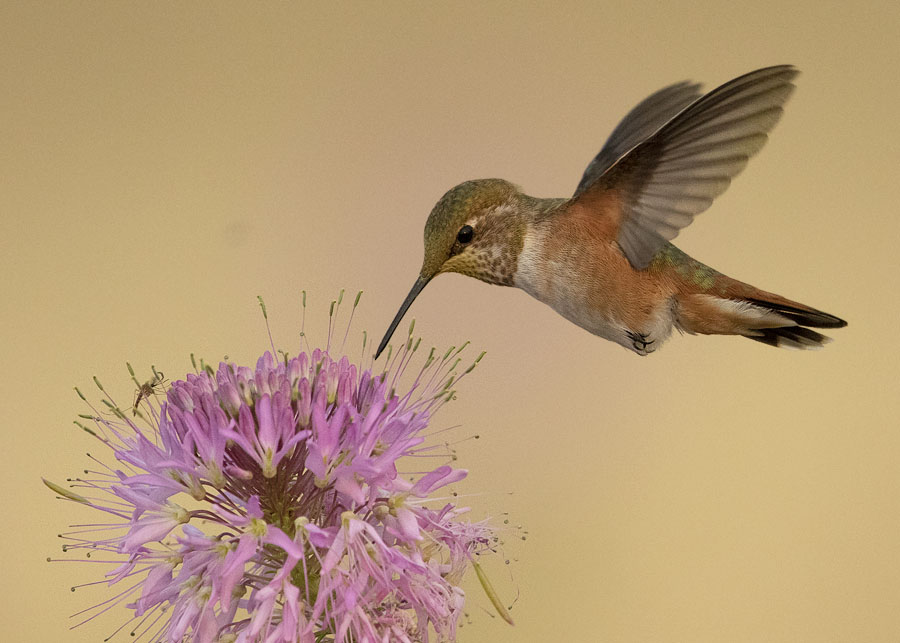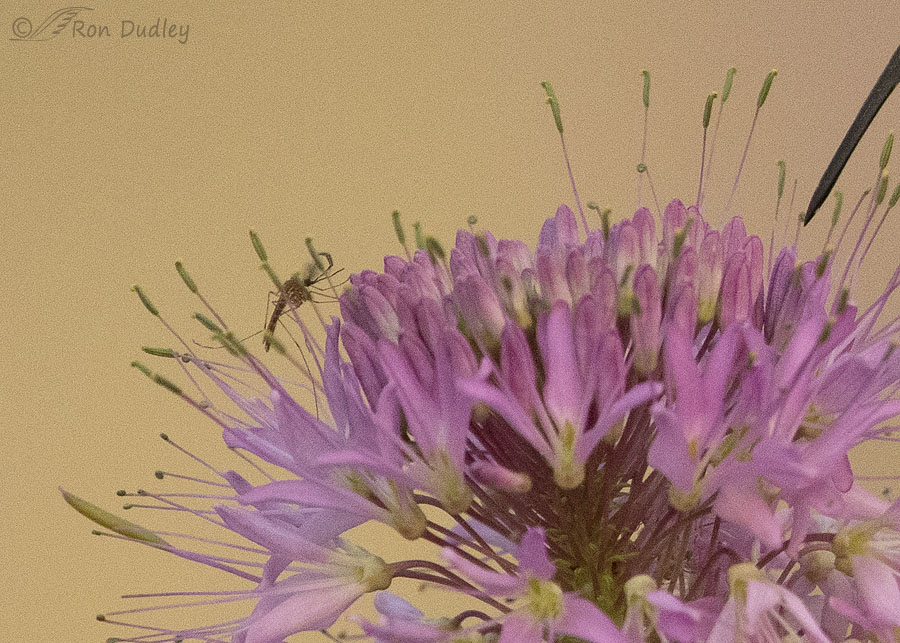Unusual flower-fellows.
I’ve photographed a variety of insects on the flowers being fed on by hummingbirds but a crane fly is a new one for me.

1/4000, f/5.6, ISO 1600, Canon 7D Mark II, Canon EF 500mm f/4L IS II USM + EF 1.4 III Extender, not baited, set up or called in
This is another photo of a Rufous Hummingbird nectaring on bee plant taken on Antelope Island on a very smoky morning nine days ago. It wasn’t until last night that I noticed the crane fly on the flower cluster. I always enjoy photos like this because of their ecological implications and the interesting variety of pollinators I see sharing the nectar resource. For me it’s a bit like a treasure hunt as I review my photos looking for various insects on the flowers.
At first I wasn’t sure this was a crane fly because it appears to be smaller than most crane flies I see but when I zoomed in on the high resolution image I became fairly sure that it was. There are many species of crane flies and I presume that they vary in size.
But I’m slightly confused about one thing – what was it doing on the flower? I suspected that it was probably competing with the hummingbird for nectar so to help me confirm that suspicion I did a little research on the diet of adult crane flies but I got a variety of inconsistent results. At least one site flatly states that crane fly adults eat nectar but others state that they eat little or nothing and other sites say they eat nothing at all during their short life span as adults.
To me that’s even more evidence that research done on the internet needs to be taken with an entire shaker of salt.
Ron
Note: I’m not absolutely positive that the insect isn’t an unusually large and long-legged mosquito – I’m certainly no entomologist. Either way it’s a new insect for me sharing a flower with a hummingbird.
What do you think?



The winged creature on the right is a hummingbird. 😉 Hope that helps. 😂😹
(Sorry. I couldn’t resist. Honestly, I have no idea. The insect in question looks smaller than the crane flies that like to hang out in my house.)
Marty, it’s smaller than most crane flies than I see too. But there are lots of crane fly species…
Fascinating (as are the comments).
And a strong reminder just how much interconnectivity (is that a word) there is… Across a vast array of species, including those considered by many to be insignificant.
Well said, EC.
Very nice pictures. However, I do not think the insect is a crane fly. I have never seen hairy antennae or appendages such as this one shows. I think it is a midge of some form. I googled midge images, and there are a number of similar insects there.
Tony, I never thought of the midge possibility but you could be right. Although the midges I see around here, and we have a lot of them, are black.
I’ll take a wild guess and say crane fly based on the photos in my guide, which show them with much longer abdomens than mosquitoes. The guide also says “Most adults do not feed, though some take nectar.” But about mosquitoes it says “Adults visit flowers for nectar.” Hard to tell without a good look at the halteres, anal veins, ocelli, etc. Glad I could help🤪
“Glad I could help”
You’re nearly always a help, Lyle – even when you don’t have the definitive answer.
Looks to me like a male mosquito. Fuzzy antennae == male
Could be, Michael.
I certainly don’t know insects well but it does look like a cranefly. I could easily be talked out of that by someone who knows better. It has always been my understanding that craneflies don’t feed as adults and often don’t even have complete mouth parts. But there are many species of craneflies and I suppose there is much variation between species. It could be seeking nectar or simply seeking moisture. And maybe it’s just a convenient perch. No matter what the answer, it’s always fun to see different parts of nature come together in different ways.
Dan, I think the “convenient perch” option is fairly likely.
Interesting subjects and a beautiful Hummingbird shot! Keep-em coming!
Thank you, Ernest.
No idea Ron although it does at least look something like a mosquito. I have never knowingly seen a Crane fly nor ever heard of such an insect. Will be interesting to see if any of your followers can ID it. Great shot of the Rufous once again.
Everett, I think crane flies look like mosquitos on steroids, with super-long legs.
No Idea! Hopefully others WILL know what it is for sure….. 🙂 Various flowers certainly do support many……
I can’t tell for sure either, Judy.